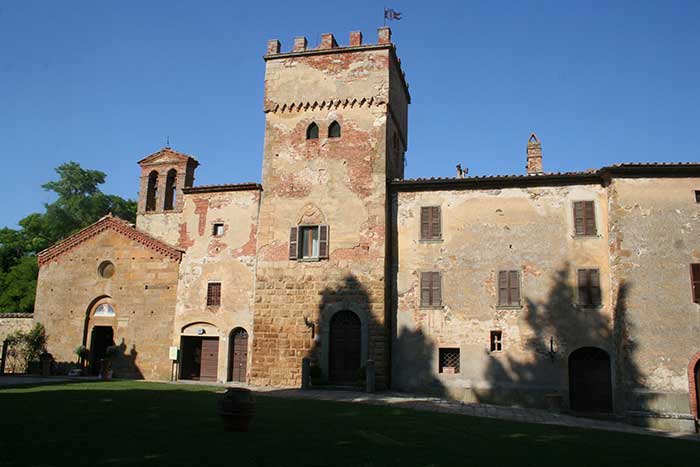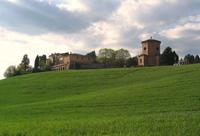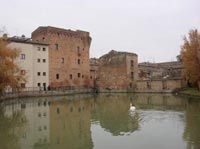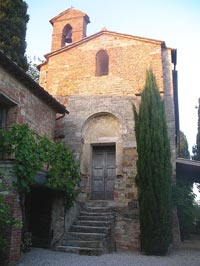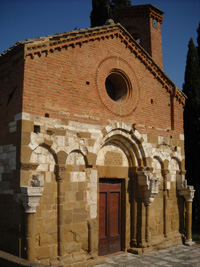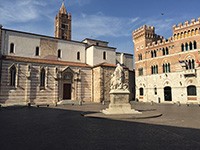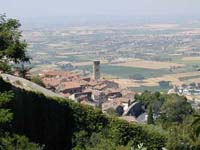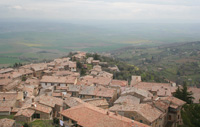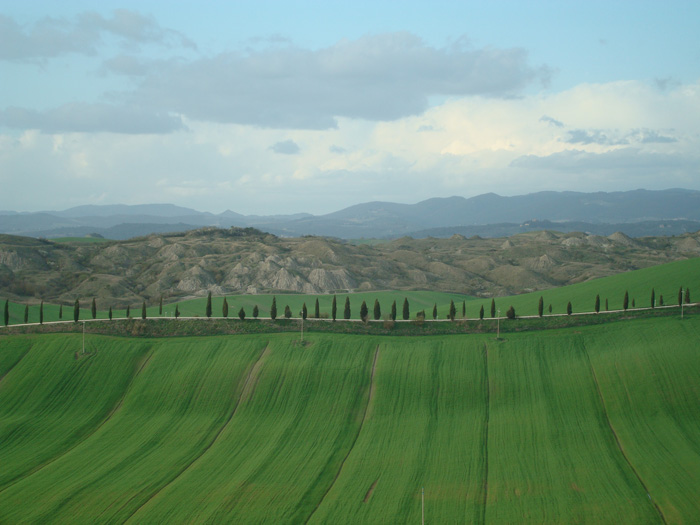 |
|
Val d'Orcia, April
|
|
|
Crete senesi is the name of a vast area in southern Tuscany, stretching between the provinces of Siena and Arezzo. The Crete Senesi is known for its soft hills and many consider it to be the most beautiful part of this region. The Crete Senesi is home to some of the most remote vestiges of the Sienese heritage, with its towers and castles reaching toward the sky and its enchanting landscape in the Val d'Orcia. Driving from Siena to Montalcino, the capital of Brunello wines, the views are unforgettable and stops at the Sacred Art Museum at Asciano and the stunning Abbey of Monteoliveto Maggiore are absolute musts. |
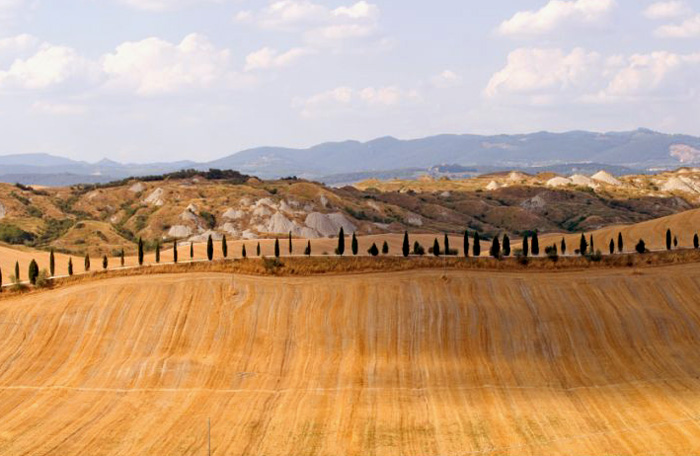 |
Val d'Orcia, August |
| Asciano |
|||||||||||||||||||||||||||||||||||||
| Asciano lies in the foothills of the Crete, in the upper valley of the Ombrone river between Siena and the Valdichiana. Asciano is a typical medieval borough, surrounded by 14th century walls. During the Middle Ages the village of Asciano was for a long time disputed by the bishops of the powerful cities of Siena and Arezzo both of which wanted to broaden their jurisdiction to the Parish of Asciano, whose construction dates back to the time of the Longobards. Among the most important monuments at Asciano we would like to mention the Basilica of St. Agatha, the Church of St. Francis, the church of St. Agostino, the Gallic castle, the Leolina Castle, the Tower of St. Albert and the Corboli Palazzo, today the venue of the Museum of Archaeology and Sacred Art. [read more] |
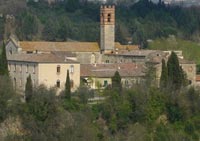 |
||||||||||||||||||||||||||||||||||||
Buonconvento Buonconvento is an ancient settlement in the more gentle side of Siena area. Buonconvento is now an important rural centre, thanks to its particular and strategic position, where the rivers Arbia and Ombrone join together, along the Via Francigena. The first residential settlements in the area of Buonconvento probably go back to the Etruscan and Roman Ages. Despite this historical data about the foundation of the village, its development starts on the 12th century, when the village already had a great importance as a place where the trading activities took place, promoted this latter by the closeness to the two rivers and to its position on the Via Francigena, one of Europe's major routes in the Middle Ages. Among the most important monuments to see in Buonconvento we point out here the Parrocchiale di San Pietro, the Oratorio di San Sebastiano, the Palazzo Ricci, hosting today the Holy Art Museum of the valley of Arbia. Inside the walls, the village is crossed from north to south by Via Soccini, the most aristocratic street in Buonconvento, with several palazzi. Palazzo Podestarile, with the 14th-century rectangular civic tower and the two Gothic arches in the façade, the Palazzo Comunale, or Town Hall, with its attractive brick front, and the imposing Palazzo Taja, built entirely in brick, and across from it is Palazzo Borghesi, built in the 14th century, which belonged to an old Sienese family whose coat of arms can be seen on the splendid façade. The important art works by Sienese artists such as Duccio di Boninsegna, Sano di Pietro, Andrea di Bartoio and Lucca di Tommè that were originally located in the Parrocchiale di San Pietro, are now in the Val d'Arbia Museum of Sacred Art, in the 19th-century Palazzo Ricci-Socini which is further down the Via Soccini. |
|||||||||||||||||||||||||||||||||||||
| Castelnuovo Tancredi. The ancient castle is composed of a tower dating back to the eleventh century, and the later added Medicean style villa in the sixteenth century. Still later a church was constructed adjacent to the main villa, which was dedicated to the Saint Bartolomeo. On the main altar Lorenzetti dedicated a marvelous painting to the Madonna and her Child which can be admired today in the Buonconvento museum of Sacred Art. |
|
||||||||||||||||||||||||||||||||||||
| The fortified settlement of Bibbiano, commanding from a hill the Ombrone Valley and the underlying town of Buonconvento, dates back to the year 850. Bibbiano castle is made up of two structures, the keep and the double walled enclosure surrounded by the ditch, running on three of the four sides. The unique gatehouse is finely framed with sandstone ashlars and protected by a great number of arrowslits and loopholes. Facing the inner curtain is still visible the wall walk. The complex is, mainly for its still intact medieval aspect, one of most remarkable of the whole Sienese countryside. Today is private property visible only from the outside. | |||||||||||||||||||||||||||||||||||||
| The actual fortified village of Murlo, consisting of the imposing bishop's palace and its courtyard, has been expertly restored and is now centred on the magnificient Antiquarium, where the archaeological finds from the greatly significant site of Poggio Civitate are gathered. Palazzo Vescovile was erected on the site of an pre-existing Abbey first Benedettina then Camaldolese. The Duomo is dedicated to S. Giovanno Evangelista. Initially it was the Abbey Church, enlarged and modified from 1300 in the subsequent centuries until the radical intervention of 1936-1945. The interior has three naves on columns and of Roman structure with Gothic influences, and hosts exquisite works of art. Nearby are the ruins of Crevole Castle, whose cleft tower rises up blade-like from the dark green of the holm oaks to cut sharply into the sky. | |||||||||||||||||||||||||||||||||||||
Near Murlo is Vescovado Di Murlo, an important centre that was formed by joining the villages Andica and Tinoni which were still separate at the beginning of the 19th century. In Vescovado the parish church of San Fortunato retains the large altarpiece in the form of a triptych by Benvenuto di Giovanni signed and dated 1475 representing the Madonna enthroned with Child, musician angels and Saints Catherine, Archangel Michael, Blaise and Lucy and above the Benedictory Christ and the Saints Ansano and Lawrence. This is a work of great formal elegance in which the consideration of the new ideas about perspective, derived from Vecchietta is here quite evident.
|
|||||||||||||||||||||||||||||||||||||
| |
|||||||||||||||||||||||||||||||||||||
| The comune Trequanda comprises the three villages of Trequanda, Petroio and Castelmuzio. Petroio (13th century) is built on a curious circular plan and is one of the best brick castles in the region. Trequanda, a slighter larger village also preserves a good section of its castle. A third of the village is taken up by the castle Cacciaconti and its various annexes including a small ornamental garden. The majestic stone tower, partly rebuilt after the war, dominates the entire complex from the north-east and is a singular witness to the original fortified castle structure. The Romanesque parish Chiesa dei SS. Pietro e Andrea has a brown-and-white chequered stone facade. Inside is a fresco of the Trasfiguration by Sodoma and a triptych by Giovanni di Paolo with Madonna and Child. The romanic church of Saint Stefano a Cennano is also of particular interest. Castelmuzio is an intact Tuscan hilltop village on an age-old Etruscan road that linked Chiusi and Siena, two major Etruscan cities 2500 years ago. As the rest of the surrounding territory Castelmuzio belonged to Cacciaconti. Its inhabitants call it Castle even if some historical texts of the Archives of Siena's State name it Castel Mozzo. The important monuments are the Spetale of San Giovanni Batiste, Palazzo Fratini, the Center of the Confraternita di San Bernardino and the SS. Trinità.Just across the valley is the monastery where The English Patient was filmed, . The church of San Giorgio is at Petroio, close to Trequanda. A few kilometres to the northeast of Petroio is the Abbadia a Sicille, a beautiful Italian old village. |
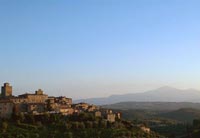 Petroio |
||||||||||||||||||||||||||||||||||||
Abbadia a Sicille |
|||||||||||||||||||||||||||||||||||||
| Abbadia a Sicille is an old village in the hills around Siena, on the ridge that separes the Chiana and the Orcia valleys. The church and the monastery have a long history: the first records of Badia di Santa Maria a Sicille date back to around 1000 AD and the inscription above the church door reads 1263. From the maltese crosses decorating the door frame it can be deduced that the convent was of the Templari order and so was used by pilgrims in search of shelter; it then passed to the Olivetani who were the owners until 1810. |
|||||||||||||||||||||||||||||||||||||
| Monteroni d'Arbia |
|||||||||||||||||||||||||||||||||||||
| Monteroni d'Arbia is located on the right bank of the Arbia river. The 14th century fortified mill, whose great brick tower makes it easily visible, bears witness to the importance of this place in agricultural production. In the days of the ancient Sienese Republic, Monteroni d'Arbia was a very important farm. The town was fortified between 1322 and 1324 for its strategic position near the so-called “Via Francigena” and over the following years acquired a considerable economic importance, so much so that in 1382 it claimed autonomy. Despite this request, in the same year Monteroni d’Arbia was included in the Vicariate of Lucignano d’Arbia. In the XIII century Monteroni d’Arbia was under Siena’s powerful influence, nevertheless the actual development and consolidation of the town took place in the following century thanks to the work of the nearby Hospital of Santa Maria della Scala that built a fortified mill, around which the community of Monteroni d’Arbia built up its first inhabited settlements. Among the most important monuments at Monteroni d’Arbia we would like to mention here the Church of St. Jacopo and St. Christopher, the Parish of Corsano and the Mill. The church of Saint Fabiano is situated in the commune of Monteroni d'Arbia. Collocated inside the homonymous castle, it belonged to the parish of Lucignano, so, owing to the scarcity of the incomes, it was joined to the parish of Monteroni during the XVI centu. The pieve dates from before 1031. With a nave and a semi-circular apse, it is an example of Romanesque architecture with Pisan and Lombard influences. It houses two canvasses by Alessandro Casolari. The church shows its most interesting pattern in the ancient external drape in bricks. Provided with a domical bell tower, it keeps some decorative elements on the front, like the architrave of the portal with the Forteguerris' coat of arms of 1657. Among the numerous events that regularly take place in Monteroni d’Arbia of most interest is the traditional “Festival of Ponte a Tressa” which is held every year from the 6th to the 9th of September. www.comune.monteronidarbia.si.it |
|
||||||||||||||||||||||||||||||||||||
| Taking the Cassia in the direction of Buonconvento you soon come to Lucignano d'Arbia, a fortified village where the Romanesque parish church of San Giovanni Battista frescoed in the 6th century by Arcangelo Salimbeni is well worth a visit. Setting out once more from the Cassia, the road leading to Radi follows another splendid stretch of the Crete. Lucignano d'Arbia is a fortified village with thirteenth century gates and keeps, where the Via Francigena passed through in ancient times. The twelfth century parish church, dedicated to St. John the Baptist, holds a Crucifixion by Bartolomeo Neri (Riccio). la Pieve di San Giovanni Battista a Lucignano d'Arbia |
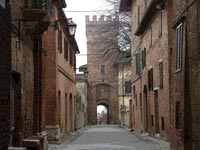 Lucignano d'Arbia |
||||||||||||||||||||||||||||||||||||
| The chapel Pierli Nerli is in Quinciano, in the Commune of Monteroni d'Arbia. It was erected by order of the Count Ferdinando Pierli Nerli, who assigned the project to Giulio Rossi. When he died, it was finished in 1861 by Giuseppe Partini. It is a sort of anthology of the sienese purist culture of the second half of the XIX century. The building, with a rectangular plant, external face in bricks, is covered by a cross vault; the entrance portal is preceded by a narthex with pinnacle. The inside is illuminated by four circular eyes. In the ceiling of the vaults, Cesare Maccari frescoed the Four Evangelists on the walls; Alessandro Franchi painted the "Four cardinal virtues". |
|||||||||||||||||||||||||||||||||||||
| From the 12th and 13th centuries the Hospice of Spedale of Santa Maria della Scala of Siena took interest in the daily life of the hill community of Cuna, in the Val d'Arbia near the important fortified water mill of Monteroni d'Arbia. Here since the 1152 rose a hospice to give shelter to the pilgrims and merchants traveling throughout the Francigena Road. The Grancia of Cuna is the best kept proof of a Medieval fortified farm, and one of the most particular and interesting architectural complex of the sienese country and the whole Tuscany. The complex was entirely build in red bricks. The original nucleus can be recognized in the so called 'farm-fortress', a great and high building with square shape and scarped walls located in the core of the architectural complex, characterized by the compact structures of the granaries and the two towers, endowed with machicoulis, sited at the corners of the southern side. |
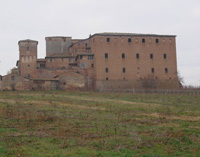 |
||||||||||||||||||||||||||||||||||||
| Castle of Gallico |
|||||||||||||||||||||||||||||||||||||
| The Castle of Gallico, with its five towers in stone and red bricks, is an interesting example of a fortified farm. Its imposing structure rises solitary on the tableland of the Crete in the Commune of Asciano, not far from the village of Montecalvoli. The sienese family of Tolomei bought the castle of Gallico in 1319 and, towards the end of the century, it enlarged the already existent tower for keeping there the products of the land. Later it became a castle-grancia. The Griffolis, rich merchants of silk from Montepulciano, bought it in the first half of the XV century and the sienese republic obliged them to keep there a garrison of soldiers to defend this important strategic outpost. Passed through different owners, towards the end of the XVIII century, it was given to the Hospital of Santa Maria della Scala of Siena. Today,the castle has been carefully restored and enclosed, so that, unfortunately, now you can admire it only from far off. |
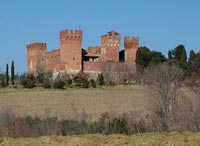 |
||||||||||||||||||||||||||||||||||||
| San Giovanni d'Asso is located in the heart of the Crete Senesi, about 8 km south-eastwards from Buonconvento. It is situated on a clayed cliff on the right bank of the river Asso. It is one of the numerous villages which have taken their name from their mother-church of San Giovanni and Saint Maria in Pava, of which the memory dates back to the Longobardic age. Located at the top of a hill, by whose slopes run the torrent of the Asso River and impended over by an ancient castle, the populated centre of San Giovanni d'Asso is the chief town of a municipal territory which includes the hamlets of Montisi, Lucignano d'Asso, Monterongriffoli, Vergelle and Pieve a Salti. The Castle is located in the higher part of town, called Borghetto, whose origins date back to the thirteenth and fourteenth centuries from designs by Agostino and Agnolo di Ventura, Sienese architects. Worth visiting are the Romanesque church of San Giovanni Battista and, lower down, the church of San Pietro in Villore (11th - 12th century). Among the agricultural products, the white truffle is precious and famous throughout Italy. Within the municipal territory rises the picturesque village of Montisi, with its Chiesa dell'Annunziata and its historical grain tower, and the extraordinary white road of Pieve a Salti. Here, every year, on the Sunday nearest the 5th of August (the festival of the Madonna delle Nevi, the patron saint of Montisi) the joust "Giostra di Simone" is held. Montelifre Castle is also important, while at Pava the historical parish church is significant. |
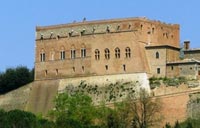 |
||||||||||||||||||||||||||||||||||||
| The old baptismal temple reduced to a chapel is still visible between Monterongrifoli and San Giovanni d’Asso, under the ancient name of Pieve a Pava (the parish of Pava). It has an octagonal shape and an architectonic style which belongs to a period which preceded the decline of the fine arts. Saint Maria in Pava was one of the nineteen parishes which were contended in the Middle Ages between the dioceses of Siena and Arezzo. The front to which we enter by means of a small stairway, leaned against the ancient parsonage is very simple, in travertine ashlars and bricks; the archivolt portal, without a plastic decoration is enriched with a fragmentary frescoed lunette maybe of the XIV century, representing the Madonna with Christ Child and two Saints. The lateral face of the building is in travertine ashlars. Recovered after decades of abandon, it is nowadays a private property. |
|
||||||||||||||||||||||||||||||||||||
| San Pietro in Villore in San Giovanni d'Asso Adorned by cypresses, San Pietro in Villore is without a doubt the most important church of the area. The pieve has only one nave with semi-circular apse and covering with cross vaults, held up by a transversal arch on semi pilasters. Fruit of a restoration of the XX century is the ribbed bell –tower. The crypt is divided into 4 small naves of three spans. The front has its superior part in fired-brick, surrounded by a recurrence of bricks disposed as teeth a sow, held up by small corbels. The inferior part is scanned by five small arches; in the central one, wider, is kept the portal in the lunette of which is put a sculptural fragment of the High Middle Age. The small capital of the semi-columns which held up the arches are decorated with geometrical and anthropomorphic motives. Also the apse shows a very rich plastic decoration. |
|||||||||||||||||||||||||||||||||||||
Until 1949 Rapolano Terme was known simply as Rapolano. Ever since Roman times, however, Rapolano has been best known for its thermal waters. |
|||||||||||||||||||||||||||||||||||||
| San Gimignanello was first an important small fortress and then villa Sansedoni, with a farmhouse and a parish(SS. Fabiano and Sebastiano). The church of the Madonna della Piaggia is a sacred building among San Gimignanello and Serre di Rapolano. The church was built to protect and enclose an ancient tabernacle with a fourteenth-century-fresco which represents the Madonna with Christ Child, attributable to Lippo Vanni, enclosed in a cornice in stucco of the XVIII century. The chiesa Madonna della Piaggia was founded in 1407 by the “grancere” of Serre and, at the time of the rector of the Hospital of Santa Maria della Scala Paolo di Paolo Serfucci, who wanted to build a church dedicated to Saint Maria Maddalena, not only in the granary but also in the country. |
|||||||||||||||||||||||||||||||||||||
| Poggio Santa Cecilia is a splendid village on a hillock few kilometres from Rapolano Terme, to which it is linked by a country road which starts from the ancient Thermae of Querciolaia. Poggio Santa Cecilia is a phantom village, it is completely deserted. The name of this village is mentioned in the splendid book Garibaldian itineraries in Tuscany and environs 1848-1867 by Francesco Asso, published by the Tuscany region, because here Giuseppe Garibaldi stayed for some days when he came here to undergo treatments at the Thermae of Querciolaia for his wound on a foot, which he got in Aspromonte. Chiesa di San Pietro in Poggio Santa Cecilia As it may be seen in a memorial plaque at the entrance, the parish of the ancient church of Santa Maria in Ferrata was moved there, near to the castle, in 1798. The façade is classical, with side pilasters and a stone triangular tympan portal encircled by the crest of Pietro Buoninsegni from 1690, which certifies the family patronage. Inside the single nave with three altars, was completely restored in the XIX century. In fact in the decade 1820-30 there were executed: the stucco high altar, the choir stalls, the wall temperas with sacred subjects by Vincenzo Dei, which have been partially substituted in the presbytery area with wall paintings by P. Sorio, dated 1943. La chiesa di S. Maria in Ferrata Poggio Santa Cecilia Un borgo disabitato | Gianni Mafucci (it) Crete Senesi, Biancane hills in the badlands of Accona Desert |
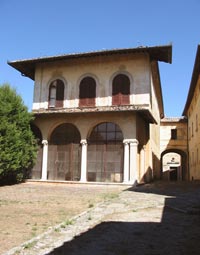 Piazza Garibaldi in Poggio Santa Cecilia, a completely deserted village |
||||||||||||||||||||||||||||||||||||
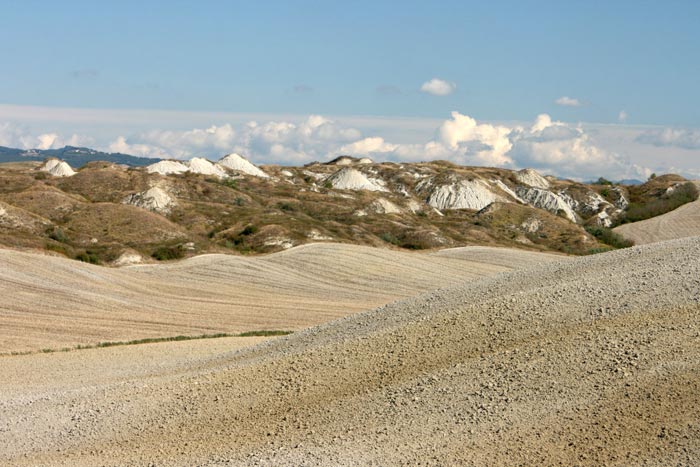 |
|||||||||||||||||||||||||||||||||||||
|
|||||||||||||||||||||||||||||||||||||
| The Accona Desert or deserto di Accona is a semi-arid area in the center of Crete senesi, near the comune of Asciano. It is characterized by calanques and dome-shaped formations locally known as biancane (deriving from Italian bianco, white, due to their light shade). This characteristic clay, known as mattaione, represents the sediments of the Pliocene sea which covered the area between 2.5 and 4.5 million years ago. Surrounded by Valdichiana, Val d`Orcia, Valdelsa and the Chianti, this bare and almost plantless region, which has been called "Deserto di Accona" (Accona desert) since the Middle Ages, reaches the foot of the Mount Amiata. The Crete senese are divided into the municipalities of Asciano, Buonconvento, Monteroni d`Arbia, Rapolano Terme and San Giovanni d`Asso. |
|||||||||||||||||||||||||||||||||||||
View Crete Senesi in a larger map
|
|||||||||||||||||||||||||||||||||||||
| Arbia, Chiusure, Castelnuovo Scalo en Torre a Castello are frazioni of Asciano. Lucignano, More di Cuna, Ponte a Tressa, Ponte d'Arbia, Radi, Ville di Corsano are frazioni of Monteroni d'Arbia. Armaiolo, Modanella, Poggio Santa Cecilia, San Gimignanello and Serre di Rapolano are frazioni of Rapolano Terme. Distances from Podere Santa Pia | Buonconvento 46 km | San Giovanni d'Asso 51 km| Trequanda 62 km | Asciano 64 km | Montalcino 34 km |
|||||||||||||||||||||||||||||||||||||
Val d'Arbia is an official DOC appellation of Tuscany. Val d’Arbia is a large area within Siena Province bordering on the Chianti and is famous, among other things, for a battle fought there between Siena and Florence in 1260, described by Dante in The Divine Comedy. For many centuries the territory has been identified with white wine, now known as Val d’Arbia DOC and produced in twelve townships of Siena Province. The Val d’Arbia DOC area includes Castellina in Chianti, Radda in Chianti, Gaiole in Chianti, Monteriggioni, Castelnuovo Berardenga, Sovicille, Asciano, Monteroni d'Arbia, and Buonconvento, all in Siena Province.
|
|||||||||||||||||||||||||||||||||||||
| Casolari diroccati nelle crete senesi a Radi, Monteroni d'Arbia, Siena Uninhabited farmhouses in the crete senesi in Radi, Monteroni d'Arbia, Siena Per la memoria… questa splendida foto di @rosso2803 che immortala un angolo delle crete senesi.
|
|||||||||||||||||||||||||||||||||||||
Il Palagio About 45 minutes southeast of Florence, Italy, near the town of Figline Valdarno, there’s a place called Sting’s Café. This establishment is known to only a handful of insiders; to visit, you must first snag an invitation to Sting’s Tuscan home, a 900-acre estate known as Il Palagio, where the yoga-toned musician, his producer/actor/philanthropist wife, Trudie Styler, and their family spend the end of every summer.
|
|||||||||||||||||||||||||||||||||||||
|
|||||||||||||||||||||||||||||||||||||

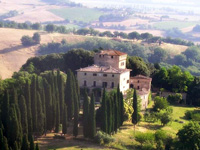 Castelnuovo Tancredi
Castelnuovo Tancredi 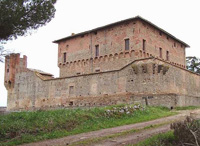 Bibbiano castle
Bibbiano castle 